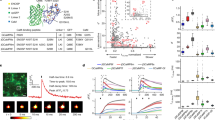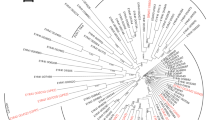Abstract
THE resistance of ticks to chemical methods of control is an increasingly serious problem1–5, and new classes of compounds with high acaricidal activity and low mammalian toxicity are needed urgently. In the search for novel acaricides the nervous system is a prime target, and, in spite of evidence about the role of γ-aminobutyrate and gluta-mate in arthropod nervous transmission, acetylcholine is the only well established neurotransmitter6–9. So far only acetylcholinesterases have achieved an important role in the disruption of cholinergic neurotransmission. Anti-cholinergics, such as atropine, are ineffective, and cholino-mimetics other than nicotine have been little investigated. We now report that certain muscarinic agonists are potent acaricides.
This is a preview of subscription content, access via your institution
Access options
Subscribe to this journal
Receive 51 print issues and online access
$199.00 per year
only $3.90 per issue
Buy this article
- Purchase on Springer Link
- Instant access to full article PDF
Prices may be subject to local taxes which are calculated during checkout
Similar content being viewed by others
References
Whitehead, G. B., Adv. Acarol. 2, 53–70 (1965).
Roulston, W. J., and Wharton, R. H., Aust. Vet. J., 43, 129–134 (1967).
Shaw, R. D., Cook, M., and Carson, R. E., J. econ. Ent., 61, 1590–1594 (1968).
Wharton, R. H., and Roulston, W. J., A. Rev. Ent., 15, 381–404 (1970).
Harrison, I. R., Palmer, B. H., and Wilmhurst, E. C., Pesticide Sci., 4, 531–542 (1973).
O'Connor, A. K., O'Brien, R. D., and Salpeter, M. M., J. Insect. Physiol., 11, 1351–1358 (1965).
Faeder, I. R., O'Brien, R. D., and Salpeter, M. M., J. exp. Zool., 173, 187–202 (1970).
Pitman, R. M., Comp. gen. Pharmac., 2, 347–371 (1971).
Gerschenfeld, H. M., Physiol. Rev., 53, 1–119 (1973).
Hanin, I., Jenden, D. J., and Cho, A. K., Molec. Pharmac., 2, 352–359 (1966).
Bebbington, A., Brimblecombe, R. W., and Shakeshaft, D., Br. J. Pharmac., 26, 56–67 (1966).
Levy, J., and Michel-Ber, E., C. r. Séanc. hebd. Acad. Sci, Paris, 262, 2546–2549 (1966).
Levy, J., and Michel-Ber, E., Therapie, 22, 671–688 (1967).
Karlen, B., Acta. pharm. suecica, 7, 169–200 (1970).
Author information
Authors and Affiliations
Rights and permissions
About this article
Cite this article
BIGG, D., PURVIS, S. Muscarinic agonists provide a new class of acaricide. Nature 262, 220–222 (1976). https://doi.org/10.1038/262220a0
Received:
Accepted:
Published:
Issue Date:
DOI: https://doi.org/10.1038/262220a0
Comments
By submitting a comment you agree to abide by our Terms and Community Guidelines. If you find something abusive or that does not comply with our terms or guidelines please flag it as inappropriate.



